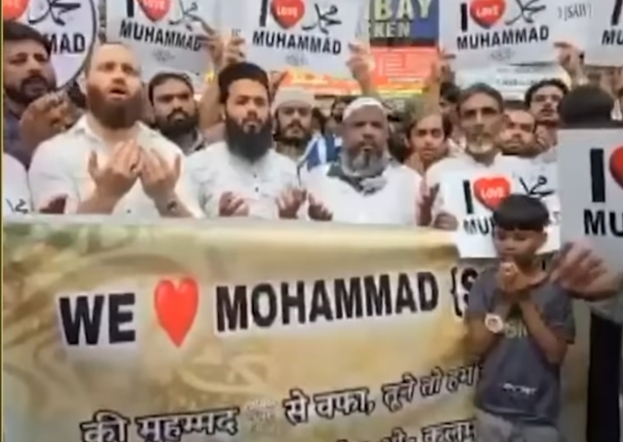‘I Love Muhammad’: From A Banner To A Crisis!
A lightboard in a Kanpur procession in early September — reading “I Love Muhammad” — has detonated a combustible mix of politics, policing and piety across Uttar Pradesh. What began as an expression of love during an Eid-Milad procession has morphed into night-long sit-ins, stone-pelting, mass FIRs and the arrest of prominent clerics.
In Bareilly alone, police say more than 2,000 people have been named in multiple FIRs and several dozen detained after clashes that left policemen injured and shops damaged.
The state has responded with heavy deployments, internet shutdowns and hardliner warnings from the Chief Minister.
From a banner to a crisis: how it escalated
According to police records and media reconstructions, the row traces back to a Barawafat (Eid-Milad-un-Nabi) procession in Rawatpur, Kanpur, where organisers put up a lightboard and banners saying “I Love Muhammad.” Local Hindu groups objected, claiming the signs had been deliberately placed in a mixed neighbourhood at a time when Ram-related festivities are also observed. The complaint reached the Kanpur police, who registered an FIR. That registration—viewed by some Muslim leaders as discriminatory and by others as a routine law-and-order matter—became the spark. Within days similar placards and processions appeared in towns across UP; in several places counter-processions and aggressive pushback followed. 
What should have been a municipal permit dispute acquired the shape of a communal contest: posters were debated on TV, schools of religio-political thought mobilised followers, and social media amplified every grievance.
The result was confrontations on the street—most notably at Bareilly—where police used lathicharge to disperse protesters and subsequently lodged dozens of FIRs and made high-profile arrests. 
Policing, political theatre and the law
The government response has been unmistakable: flag marches, drone monitoring, internet curbs in affected districts and public appeals for calm from state ministers. The Chief Minister framed the events as deliberate attempts to disturb peace during festival season and warned that “people breaching peace will be crushed,” and “those dreaming of raising Gazwa-e-Hind slogans will get tickets to hell,”language that underscores securitised governance rather than community healing.
Critics say such rhetoric can legitimise a heavy-handed police response while doing little to address the underlying grievance: why an expression that invokes love for a religious figure becomes a matter of criminal law in some places but not in others. 
Police accounts stress violations of public-order conditions: unauthorised processions, alleged stone-pelting and the recovery of weapons at some sites. Authorities also argue the mobilisation was pre-planned via WhatsApp groups and public appeals, and point to damage to public property and injuries to officers as grounds for large FIRs and mass arrests. Whether the state response was proportionate—and whether it treated comparable infractions equally—are legitimate legal and political questions now before the courts and the public. 
The argument of double standards
The immediate moral question raised in markets and on social media is stark: if mass choruses of “Jai Shree Ram” and “Har Har Mahadev” in public processions are accepted or celebrated, why should “I Love Muhammad” be subject to police action or social opprobrium? For many in the Muslim community the question is not only rhetorical: it points to a pattern of selective enforcement and social sanctioning that leaves minority expressions vulnerable. Political actors on both sides have exploited this sense of grievance: for some Hindutva groups, the “I Love Muhammad” placard was a provocation that needed to be checked; for several Muslim organisations, criminalisation of the placards is evidence of systemic bias. The symmetry is imperfect—for reasons of history, political mobilization and the asymmetric memory of past communal conflicts—but the demand for parity of civic space is not. The reporting on counter-campaigns such as “I Love Mahadev” that surfaced in parts of Varanasi is an evidence of the tit-for-tat dynamics.
Who is stoking what — and why it matters
Multiple actors feed these flare-ups. Local religious leaders and clerics mobilise followers quickly; right-wing groups have been ready with counter-mobilisations; political elites deploy strong rhetoric from the state capital; and social platforms…well, they act like accelerants. The arrest of Maulana Tauqeer Raza Khan of the Ittehad-e-Millat Council in Bareilly epitomises the intersection of religious leadership and street politics; his detention has been described by supporters as victimisation and by police as necessary to restore order. Whether the mobilisation was genuinely spontaneous or strategically planned by political intermediaries is a matter of ongoing investigation. 
That ambiguity matters: when organisers believe they can score political points by staging a public show of faith, they may disregard municipal rules; when governments fear festival season violence, they prioritise containment over conversation. The citizens who suffer are ordinary shopkeepers, schoolchildren and commuters, whose livelihoods and freedom of movement are disrupted. The greater cost, however, is moral: civic rituals—religious and secular—are being converted into theatre of dominance instead of occasions for plural belonging.
The wider ripple: from local boards to national debate
Since the Kanpur incident, similar processions and poster campaigns have spread beyond Uttar Pradesh to cities in other states. In some places the matter has been resolved quietly; in others it has produced arrests and small clashes. Media coverage, predictably, has intensified the national salience of what began as a local dispute.
The internet shutdowns and the mass FIRs have added to the sense that the state is treating communal speech primarily as a security problem rather than as a governance challenge that requires dialogue and equal application of the law. 
What needs to happen now
First, proportionality. Law enforcement must distinguish between unauthorised public assemblies that threaten life and property and lawful religious expression that happens to offend other sensibilities. Second, parity. The state must ensure consistent standards when it enforces rules around loudspeakers, placards and processions—regardless of which faith is involved.
Third, politics must cool out of the squares: political operators who turn civic rituals into vote-bank signalling deepen fractures. Finally, community leaders—imams, priests, local councillors, shopkeepers—must be brought into a low-visibility mediation process to rebuild trust on the streets where people actually live.
The “I Love Muhammad” controversy is not simply a fight over a signboard. It is a test of whether India’s public sphere remains a shared space in which citizens can express devotion without fearing that the state or other communities will treat that love as a provocation.
If the state’s answer is greater securitisation and selective policing, the answer will be felt in long cycles of mistrust. If it is evenhanded governance and community engagement, this small poster can become a lesson in how plural democracies manage difference.
The choice will be visible not only in the number of FIRs filed, but in whether the next festival passes without fear. 
Hasnain Naqvi is a former member of the history faculty at St. Xavier’s College, Mumbai



